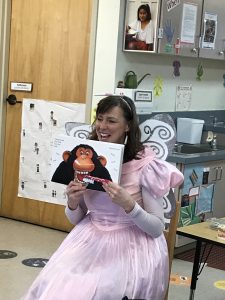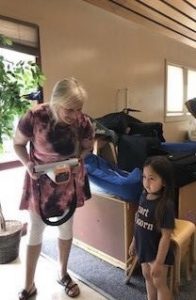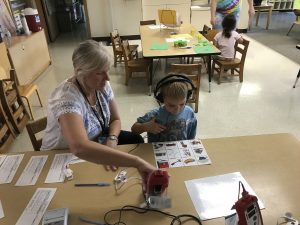About once a year, the tooth fairy makes a visit to many Sound to Harbor Early Learning Program classrooms. Tammy Questi, a dental hygienist, makes a special effort when she visits the classrooms filled with preschoolers, and it pays off. Dressed as the tooth fairy, Questi is able to captivate the children’s attention during her presentation. “She is really quite magical,” says Kristina Patnode, health services specialist for Sound to Harbor.

Over two months Tammy visits each classroom in the centers of Sound to Harbor’s educational area, across Thurston, Mason and Grays Harbor counties. The screenings and presentations that Questi performs reinforce the importance of dental hygiene at the perfect age, where children are beginning their own brushing. Students may have already begun losing their primary teeth, or are anxiously awaiting their first wiggly tooth, so Tammy has the opportunity to really make an impression.
Tammy’s tooth fairy visits are just a part of a comprehensive health program maintained by Sound to Harbor to ensure that all of the students, ranging from 3- to 5-years-old, are given the skills and support they need to be healthy throughout their school years and beyond. Sound to Harbor provides family support, screenings and educations to students in all areas of health.
Sound to Harbor takes a holistic approach to health. The program encourages family involvement and learning about healthy habits. They teach that the first step to good health is preventative care, through exercise, good nutrition and regular checkups.
Hearing and vision screenings are important in Sound to Harbor classrooms, says Patnode. “As a part of kindergarten readiness, we want to ensure to identify any vision or hearing concerns early, so students can be prepared to participate in their kindergarten classrooms,” she adds.
When students have uncorrected vision or hearing deficits, it impacts their ability to be fully involved in the classroom without educational support. Sometimes those deficits may not always be apparent. Students might seem distracted, uninterested, or seem to be misbehaving. Hearing loss can make listening to instructions in a busy classroom difficult, and it can also result in speech delay. Uncorrected vision impairment can affect a number of areas, such as letter and word recognition, hand eye coordination and more. Students that begin kindergarten with vision or hearing problems documented, and in most cases corrected, are better prepared to take part in learning. And schools can provide better support to students with vision or hearing problems once they have been identified.

By encouraging preventative healthcare and checking for well child exams and dental exams, Sound to Harbor can pinpoint where gaps may have occurred in healthcare. Then, they can support families by connecting them with providers, or assisting them to navigate health care enrollment. Families also receive a healthy living packet filled with nutritional information, active living ideas, information about sources of lead in the home, and other health concerns. Students also receive developmental screenings to ensure they are on track, or to help catch areas of concern if they arise.
Regular screenings can also check to ensure students are receiving proper nutrition. Students get their height and weight checked at the beginning and end of year, and tracked with a growth chart. Student hemoglobin levels are also check for anemia, which can be a result of nutrient deficiency or other health concerns. Sound to Harbor also works with a dietitian that can help families with nutrition plans and information.
Every day, when students have breakfast or lunch in their Sound to Harbor classroom, they sit around a table for family style dining. This offers the students the opportunity to practice social skills like sharing and manners. It also affords the opportunity for teachers to talk about food, healthy eating and good habits, both inside and outside of the classroom. Sound to Harbor meals are designed to be balanced and nutrient-dense, while also low in fat, salt and sugar. Meals include fruits, vegetables and milk, and are rich in whole grains.

“We want the best for every child, in all areas of their life; from education, to health, to family life, we want them to thrive,” Patnode says. “We want families to feel supported and know that we are here to help them.”
The Sound to Harbor mission is to ensure every child is given the care and support they need to succeed, and part of that care and support comes through the organization’s health programs. Take a look at the Sound to Harbor website to learn more about their centers and programs.
Sound to Harbor Early Learning Programs
Capital Region ESD 113
6005 Tyee Drive SW, Tumwater
360-464-6800
Sponsored











































